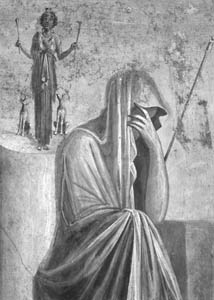![[Metroactive Stage]](/stage/gifs/stage468.gif)
[ Stage Index | Santa Cruz Week | SantaCruz Home | Archives ]
War Bytes
Bleeding-heart liberals and Greeks collide in the ill-conceived 'Agamemnon'
By Mike Connor
IF ONE HAD inadvertently wandered into the Santa Cruz Digital Arts Festival Grand Opening at the Museum of Art & History last Thursday, one would have been surprised to see, instead of the quiet austerity of the museum, blown-up digitized images on canvas and a cyborg playing electronic music as models paraded up and down stairs wearing trippy fractalized clothes. One might then have made sharp, rigid movements like C3PO while making R2D2 noises, just to get into the spirit. But regardless of what one did, one would have been impressed by the technical wizardry and know-how displayed, a promising sign of what's to come in the festival throughout the month of April.
Nigel Sanders-Self's production of Aeschylus' Agamemnon distinguishes itself as the only piece of theater in the festival, but falls short of its high-tech aspirations to make the digital theatrical. Conceived as a project of social criticism, Sanders-Self sought to highlight the parallels between ancient Grecian war and modern war to illustrate the point that thousands of years after the time of the Greeks, we're still fighting some of the same moral and spiritual battles.
In a poignant prelude to the play, historical images of war and wartime figures are projected on a large screen accompanied by quotes from the play. Lines like "violence is the force-multiplier of the weak" and "conflict born of ancient bitterness is not a thing new thought upon, but pondered deep in time" resonate with disturbing images of the hell and horror of war. The extracted quotes work beautifully on their own, and the delicate connection Sanders-Self establishes in the prelude is complimented by the ballet dancers and the singers, who express origins of the play's conflict subtly and gracefully.
But things start to go downhill when the chorus appears dressed in suits, taking turns relating the story like a panel of lecturers at a seminar for bleeding hearts outraged by war, looking down repeatedly at pages of notes. The chorus is preaching to the choir; I can say with confidence that most of us can readily imagine a horrible war without being browbeaten with overdramatic diction. The long monologues are Aeschylus' doing, but the poetry gets lost somewhere between the ancient Greek facade of the house of Atreus and the Gulf War get-ups replete with Dr. Marten boots. Indeed, this fundamental confusion of setting leaves the play stranded in an allegorical no-man's-land. We are forced to imagine a general sacrificing his own daughter to the god Artemis on his way to the Gulf War, who then returns home to be killed by his furious wife and her vengeful lover, whose father had been tricked into eating some of his own children. By and large, the horrors of modern war are born of cold, precise machines that lack the Greek sense of poetic justice inherent in cooking your enemy's kids for dinner.
Strong performances by Jennila Alldis as the tortured seer Cassandra and Irene Teegardin as the vengeful Clytaemnestra successfully salvage key lines in the play, and also manage to carve out palpable characters in this larger-than-life tragedy. But Agamemnon is not ready-made for adaptation, and while the direction Sanders-Self takes with technology and analogy is bold, the imagination and technology displayed in the production is limited.
Low-tech blue-screen work harkens back to perhaps the most memorable scene from Stanley Kubrick's classic satire Dr. Strangelove, when the bomber pilot rides a nuclear warhead like a cowboy on a bucking bronco as it falls to the ill-fated earth below. The scene, of course, looks incredibly fake, but that's part of the beauty of it. The earthbound bomb-riding cowboy is supposed to be ridiculous, and the glaring black outline separating rider and bomb from the background only adds to the absurdity of the good-hearted cowboy's gung-ho heroism. But in Agamemnon, the digitally disembodied actors deliver their lines in front of scenes of war and carnage. It's an effect which would have required a lot of expensive high-end digital compositing hardware to pull off seamlessly, but even still, the effect is unsettling at the theater where the actors could just as soon perform all their parts live.
Copyright © Metro Publishing Inc. Maintained by Boulevards New Media.
![]()
 Greek Tragedy: High-tech aspirations highlight ancient allegory to war.
Greek Tragedy: High-tech aspirations highlight ancient allegory to war.
Agamemnon plays April 12 and 13 at 8pm at the Second Stage Theater in the Performing Arts Center, UCSC; $10 general admission, $5 students and seniors; tickets available at UCSC box office. (459.2159)
From the April 10-17, 2002 issue of Metro Santa Cruz.